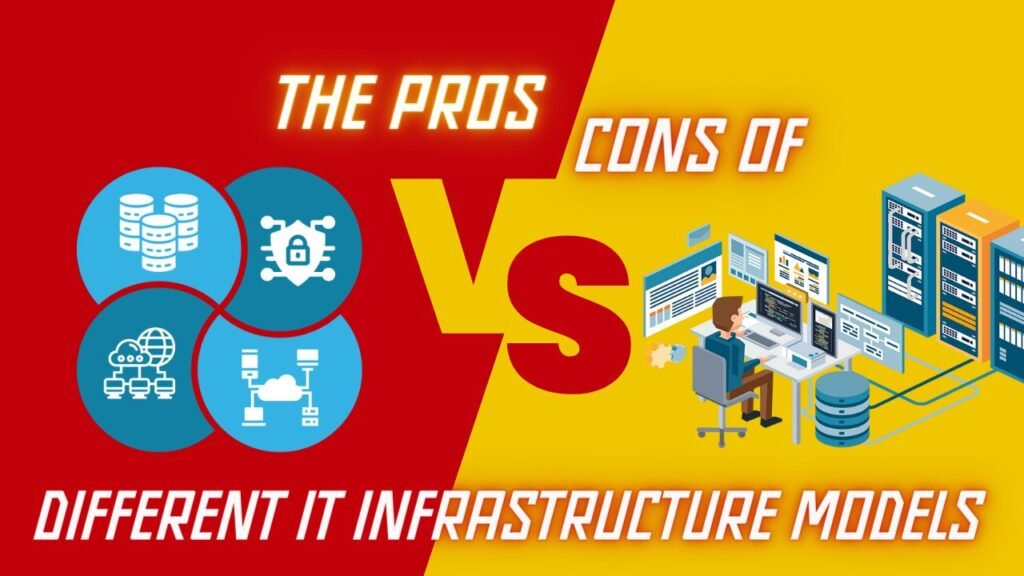Choosing the right IT infrastructure model is critical for any business, as it impacts everything from operational efficiency to scalability and cost management. With various options available, understanding the pros and cons of each can help businesses make informed decisions that align with their goals and resources. Here, we explore the different IT infrastructure models: on-premises, cloud, hybrid, and colocation, outlining their respective advantages and disadvantages.
1. On-Premises Infrastructure
Overview: On-premises infrastructure involves hosting all IT systems, servers, and data storage within the physical premises of the organization. The company owns and maintains all hardware and software.
Pros:
- Control: Complete control over hardware, software, and data, allowing for customized configurations and optimizations.
- Security: Enhanced security control, as data is stored on-site, reducing dependency on third-party providers.
- Performance: Potential for higher performance and lower latency, as systems are located within the organization’s premises.
Cons:
- Cost: High upfront capital expenditure for purchasing and maintaining hardware and software.
- Maintenance: Requires a dedicated IT team for ongoing maintenance, updates, and troubleshooting.
- Scalability: Limited scalability, as expanding infrastructure requires significant investment in additional hardware and space.
2. Cloud Infrastructure
Overview: Cloud infrastructure involves using virtual servers and storage hosted by third-party providers over the internet. Popular providers include Amazon Web Services (AWS), Microsoft Azure, and Google Cloud Platform (GCP).
Pros:
- Scalability: Easily scale resources up or down based on demand, without the need for significant upfront investment.
- Cost-Efficiency: Pay-as-you-go model allows businesses to pay only for the resources they use, reducing overall costs.
- Accessibility: Access data and applications from anywhere, enabling remote work and improving collaboration.
Cons:
- Security: Data security concerns, as sensitive information is stored off-site with third-party providers.
- Dependency: Dependence on internet connectivity and third-party service providers for uptime and performance.
- Control: Limited control over underlying hardware and infrastructure, which may be less customizable.
3. Hybrid Infrastructure
Overview: Hybrid infrastructure combines on-premises infrastructure with cloud services, allowing businesses to leverage the benefits of both models.
Pros:
- Flexibility: Flexibility to choose where to host different workloads based on performance, security, and cost considerations.
- Cost-Effective Scalability: Use cloud resources for scaling during peak times while maintaining critical systems on-premises.
- Disaster Recovery: Enhanced disaster recovery options by using cloud services for backup and failover.
Cons:
- Complexity: Increased complexity in managing and integrating on-premises and cloud environments.
- Cost: Potentially higher costs due to the need to maintain both on-premises infrastructure and cloud services.
- Security: Security management can be more challenging, requiring robust strategies to protect data across both environments.
4. Colocation Infrastructure
Overview: Colocation involves renting space in a third-party data center to house physical servers and networking equipment. The organization owns the hardware but leverages the data center’s facilities for power, cooling, and connectivity.
Pros:
- Reduced Costs: Lower costs compared to building and maintaining an in-house data center, with shared infrastructure expenses.
- Security and Reliability: Access to high-security facilities with robust physical and cyber protections, as well as reliable power and network connectivity.
- Scalability: Easier to scale by adding more equipment within the rented space without significant capital investment.
Cons:
- Distance: Potential latency issues if the colocation facility is far from the organization’s main operations.
- Control: Less control over physical access and environmental conditions compared to on-premises infrastructure.
- Management: Still requires a dedicated IT team to manage and maintain the hardware housed in the colocation facility.
Conclusion
Selecting the right IT infrastructure model depends on your business’s specific needs, budget, and long-term goals. On-premises infrastructure offers control and security but comes with high costs and limited scalability. Cloud infrastructure provides scalability and cost-efficiency but raises concerns about security and control. Hybrid infrastructure offers flexibility and disaster recovery benefits but increases complexity and potential costs. Colocation provides a balance between cost savings and security but requires careful management of physical and network resources.
By understanding the pros and cons of each model, businesses can make strategic decisions that align with their operational requirements and growth plans. Ultimately, the right choice will depend on how each model’s strengths and weaknesses fit into your organization’s unique context and future aspirations.


